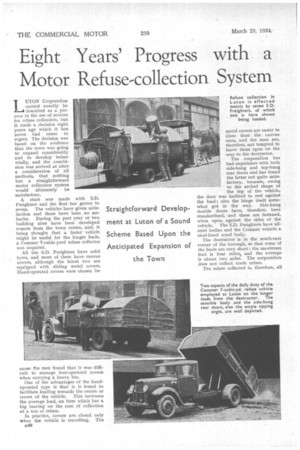Eight Years' Progress with a Motor Refuse-collection System
Page 58

Page 59

If you've noticed an error in this article please click here to report it so we can fix it.
UTON Corporation cannot exactly be described as a pioneer in the use of motors for refuse collection, but it made a decision eight years ago which it has never had cause to regret. The decision was based on the evidence that the town was going to expand considerably and to develop industrially, and the conclusion was arrived at after a consideration of all methods, that nothing but a straightforward motor collection system would ultimately be satisfactory.
A start was made with S.D. Freighters and the fleet has grown to seven. The vehicles have given satisfaction and there have been no setbacks. During the past year or two building sites have been developed remote from the town centre, and, it being thought that a faster vehicle might be useful for the longer leads, a Commer 7-cubic-yard refuse collector was acquired.
All the S.D. Freighters have solid tyres, and most of them have canvas covers, although the latest two are equipped with sliding metal covers. hand-operated covers were chosen be
cause be men found that it was difficult to manage foot-operated covers when carrying a heavy bin.
One of the advantages of the handoperated type is that it is found to facilitate loading towards the centre or crown of the vehicle. This increases the average load, an item which has a big bearing on the cost of collection of a ton of refuse.
In practice, covers are. closed only when the vehicle is travelling. The 1540 metal covers are easier to close than the canvas ones, and the men are, therefore, not tempted to leave them open on the way to the destructor.
The corporation has had experience with both side-hung and top-hung rear doors and has found the latter not quite satisfactory, because, owing to the arched shape of the top of• the vehicle, the door was inclined to rest against the load; also the hinge itself somewhat got in the way. Side-hung double doors have, therefore, been standardised, and these are fastened, when open, against the sides of the vehicle. The S.D. Freighters have allsteel bodies and the Commer vehicle a steel-lined wood body.
The destructor is in the south-east corner of the borough, so that some of the leads are very short ; the maximum lead is four miles, and the average is about two miles. The corporation does not collect trade refuse.
The refuse collected is, therefore, all of the household type, and, following the advance of civilization contains a large percentage of tins. On the whole, the refuse is light. Tins now fetch a price which pays for haling, and although no actual sorting takes place at the destructor, most of the tins are thrown out before the material reaches the fire. The heat from the destructor is used to raise steam for the sewage pump, as the whole of the sewage in Luton is pumped.
Weekly Collections Maintained.
The industrial and general development in Luton has gathered pace in the past year or two, and at present about 1,000 houses are being built per year. The population is now about 78,000. Collections, nevertheless, are maintained weekly. There is no insistence on the use of a standard bin, although the corporation has power to impose such a by-Iasv.
An aspect of importance is that the carries, on the whole, are not trouble
se1/1,:.. The town being entirely industrial, a large proportion of the property is in the form of pairs of houses served by a common side passage from the front, and except in some of the older parts there are few narrow and difficult roadways and those that exist are easily negotiated by the S.D. Freighters, which are particularly handy. Some of the gradients are as steep as 1 in 8, but the centre of the town is, in the main, fairly flat.
Five two-wheeled horse-drawn carts are employed for collection in the immediate neighbourhood of the destructor. These carts are also useful for keeping men engaged while motors are moving to and from the destructor. One cart thus serves two motors.
Costs—Motors Beat Horses.
The average load on the 7-cubic yard vehicles is 29 cwt., and the cost per ton, with the motors, is now working out at about Os. 6d., this figure including loan charges and all other expenses:' The horse-carted refuse costs about 8s. per ton to collect, and it seems likely that horses will be eliminated within a
year or two. In the year 1932-33 19,024 tons of refuse were collected, compared with only 14,000 tons in 1927-28; this shows how the town is expanding. In the latest year, 19,074 houses were served, so that there is almost exactly one ton of refuse collected per house per annum. In that year, mechanical vehicles accounted for 74 per cent. and horse-drawn vehicles were responsible for 26-per cent, of the total.
No mechanical vehicles are employed in Luton for street sweeping, this being effected byhand, and horse-drawn vehicles are used for collection. This position, again,is likely to. he -revised within the next year. A Dennis .60gallon gully and ceaspit e.mptier is -employed. -The mechanical vehicles are maintained by the bus department at its depot in Park Street.




































































































